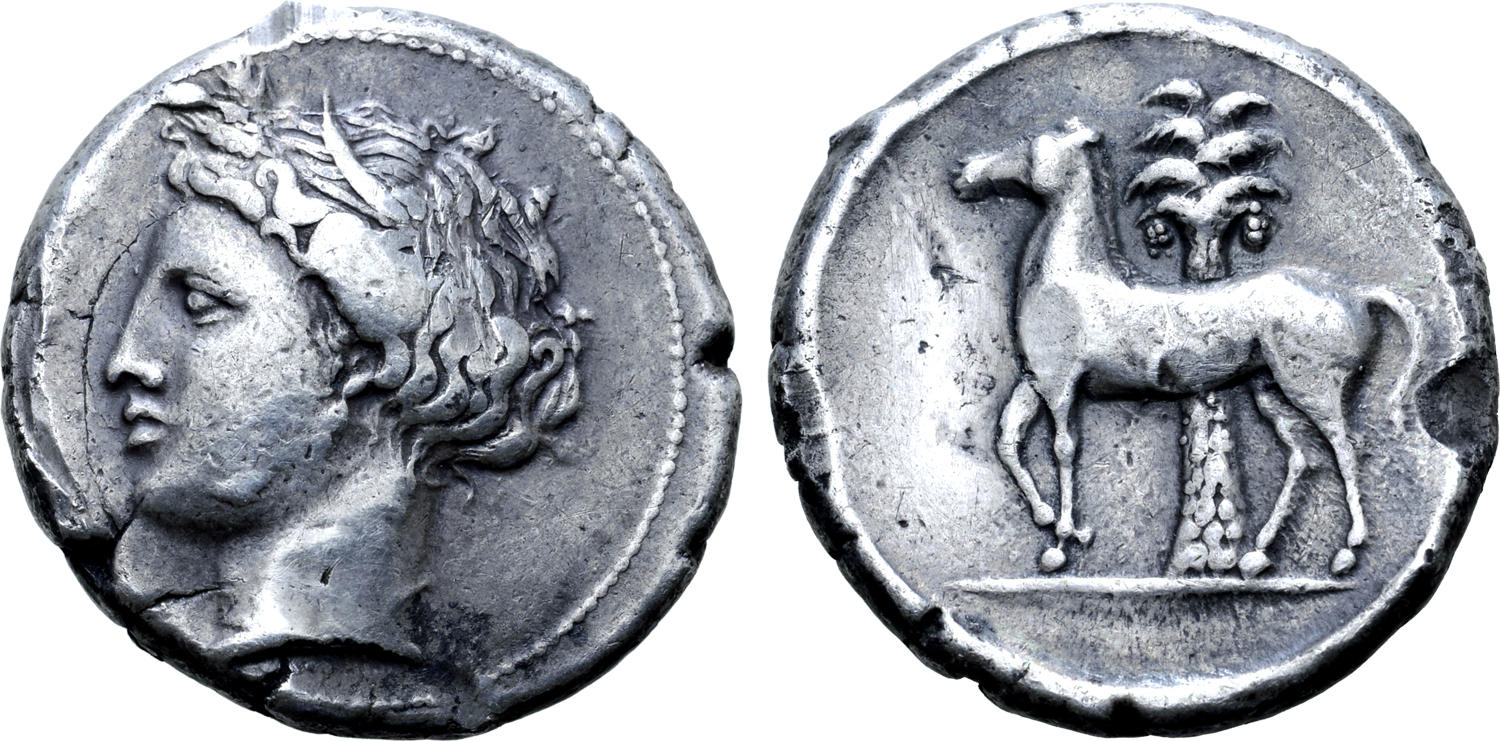H 40 - Lilybaeum or Entella (Carthage), silver, tetradrachms (350-310 BCE)
From SILVER
350 BCE - 310 BCE Silver 11,679 kg
Description
| ObverseInscription or printing placed on the obverse.: | Head of Tanit left |
| ReverseInscription or printing placed on the reverse.: | Horse standing left in front of palm tree |
Mint and issuing power
| MintIdentifies the place of manufacture or issue of a numismatic object.: | Lilybaeum | Ancient regionAncient region.: | Sicily | Modern countryModern country: Italy | AuthorityIdentifies the issuing power. The authority can be "pretended" when the name or the portrait of X is on the coin but he/she was not the issuing power. It can also be "uncertain" when there is no mention of X on the coin but he/she was the issuing power according to the historical sources: | Carthaginian Empire |
Chronology
| FromIdentifies the initial date in a range assigned in a numismatic context. | 350 BCE | toIdentifies the final date in a range assigned in a numismatic context.. | 310 BCE | PeriodTime period of the numismatic object.: Classical 480-323 BC |
Physical description
| MetalThe physical material (usually metal) from which an object is made.: | Silver |
Median weightMedian of the weights of numismatic objects (in grams). in grams | 17.00 | DenominationTerm indicating the value of a numismatic object. Examples: tetradrachm, chalkous, denarius.: | tetradrachm |
StandardStandard.: | Attic |
Image

H 40 - Lilybaeum?, silver, tetradrachm, 350-40-320-10 BC.jpg [1]
References
| Die study referencePublication of the study: | Jenkins 19771Jenkins 1977, p. 37-47, n° 49-141 (Series 2) | ||
| Coin series referenceReference to coin series study: | Sear I2Sear I, n° 6429-6432, RQEMH3RQEMH, n° 40 | ||
Obverse dies distribution
| FrequencyFrequency of specimen in distribution. ᵖ | Number of obversesNumber of obverse dies. ᵖ (o) | % (o) | Number of coinsNumber of coins. (n) | % (n) | Die nameName(s) of the die(s). |
| 1 | 1 | 2.94 | 1 | 0.28 | 20 |
| 2 | 6 | 17.65 | 12 | 3.31 | 15;16;19;26;28;29 |
| 3 | 3 | 8.82 | 9 | 2.49 | 23;27;30 |
| 5 | 5 | 14.71 | 25 | 6.91 | 17;22;34;37;41 |
| 6 | 1 | 2.94 | 6 | 1.66 | 36 |
| 7 | 2 | 5.88 | 14 | 3.87 | 13;24 |
| 8 | 3 | 8.82 | 24 | 6.63 | 18;25;40 |
| 9 | 2 | 5.88 | 18 | 4.97 | 21;45 |
| 10 | 1 | 2.94 | 10 | 2.76 | 38 |
| 12 | 1 | 2.94 | 12 | 3.31 | 32 |
| 16 | 2 | 5.88 | 32 | 8.84 | 14;44 |
| 17 | 1 | 2.94 | 17 | 4.7 | 43 |
| 20 | 1 | 2.94 | 20 | 5.52 | 46 |
| 21 | 1 | 2.94 | 21 | 5.8 | 35 |
| 26 | 1 | 2.94 | 26 | 7.18 | 39 |
| 28 | 1 | 2.94 | 28 | 7.73 | 42 |
| 39 | 1 | 2.94 | 39 | 10.77 | 31 |
| 48 | 1 | 2.94 | 48 | 13.26 | 33 |
| Total | 34 of 34 | 99.98 | 362 of 362 | 99.99 |
Reverse dies distribution
no distribution is available
Quantification
| Number of obversesNumber of obverse dies. ᵖ (o) | 34 | Number of singletons (o1)The number of singleton coins. ᵖ | 1 |
| Number of reverse diesNumber of reverse dies. (r) | 85 | Number of coinsNumber of coins. (n) | 362 |
| Coins per obverse dieNumber of coins per obverse die. (n/o) | 10.65 | Coins per reverse dieNumber of coins per reverse die. (n/r) | 4.26 |
| Reverse per obverse ratioRatio of obverse dies divided by reverse dies. (r/o) | 2.5 | Percentage of singletons (o1)number of coins (n) divided by the number of singletons (o1) ᵖ | 2.94 % |
| Original number of dies (O) (Carter 1983 formula)The estimation of the number of coins according to Carter 1983 ᵖ | 34.35 | Coins struck if 20,000 as average productivity per dieCoins made if the average productivity for obverses (according to Carter) is 20,000. ᵖ | 687,000 |
| Original number of dies (O) (Esty 2011 formula)The estimation of the number of coins according to the singleton formula in Esty 2011 ᵖ (O) | 37.52 | Survival rate if 20,000 as average productivity per dieSurvival rate if average productivity is 20,000. ᵖ | 0.00053 |
| Coverage (o = % of O) (Esty 1984 formula)Esty 1984 - coverage (% of O) ᵖ (o = % of O) | 99.72% | Die productivity if survival rate 1/2,000Average productivity if survival rate is 1/2,000. ᵖ | 21,077.15 |
| Weight of silver (in kg) if 20,000 coins per die (O = Carter formula)Carter 1983 * Median weight * 20000 (*10 if gold or electrum) ᵖ | 11,679 kg <br /> 11,679 kg | Die productivity if survival rate 1/5,000Average productivity if survival rate is 1/5,000. ᵖ | 52,692.87 |
Remarks
References
- ^ Jenkins, Gilbert Kenneth (1977), "Coins of Punic Sicily. Part 3. Carthage Series 2-4", Schweizerische numismatische Rundschau, 56, p. 5-65, pl. 1-22.
- ^ Sear, David R. (1978), Greek coins and their values. Vol. I, Europe, London, xl, 316 p.
- ^ Callataÿ, François de (1997), Recueil quantitatif des émissions monétaires hellénistiques, Numismatique Romaine, Wetteren, X + 341 p.